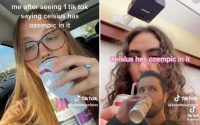What parents need to know to keep children safe
Though cases remain few, monkeypox has already hit children from New York City to Seattle and many communities in between.
Currently in the US there are just under 17,000 cases of monkeypox, mostly among adults. Though no fatalities have yet been recorded, there’s some evidence that an early strain of the virus is more likely to be severe in children under 8, according to the Centers for Disease Control and Prevention, particularly in those with immunocompromising conditions or certain skin conditions, such as eczema.
As school bells ring to call kids back to class for the fall, it’s important for parents to know everything they can about protecting their children from the painful disease.

What does monkeypox in children look like?
The symptoms of monkeypox in kids presents in a similar way to adults, according to the CDC.
It will most likely begin with a bodily rash that may resemble the signs of an allergic reaction, chickenpox, or hand, foot, and mouth disease.
The rash quickly forms lesions, which progress over the course of two to four weeks, into blisters, pustules, then scabs. Meanwhile, patients are also likely to suffer fever, swollen lymph nodes, fatigue and headache.
The risk of children and adolescents contracting the virus remains low as the few known cases among them have been quick to treatment and quarantine. Moreover, infections in US children and teenagers have been mild so far, according to the American Academy of Pediatrics.
How does monkeypox spread in children?
Monkeypox spreads in children and teens the same way it does in adult: through close personal contact. For kids, this could mean hugging another, skin-to-skin, with the infectious rash; or swapping spit, such as through kissing or very close-talking, with a sick patient.
The CDC also notes the potential for the virus to spread through contaminated objects or surfaces, including clothing, towels and linens, that were used by someone with with the virus.
It’s not known whether children are more susceptible to monkeypox than adults or whether the virus will affect them in the same way.
What should you do if a child is exposed to monkeypox?
Unlike with COVID-19 and other contagions, people exposed to the virus will not necessarily have to isolate. However, during monitoring, the health department may limit their participation in activities if investigators are unable to pinpoint where or with whom exposure first occurred, or if the exposure setting presented particularly high risks. They’ll also consider the child’s age and ability to recognize or communicate symptoms and the risk to others.
Babies are advised to stay in a separate room and not have contact with parents or caregivers who are infected or may have been exposed to monkeypox.
If your child comes in contact with someone with monkeypox, they should be watched closely for 21 days. If symptoms should arise, they should isolate away from peers and wear a mask.
On a case-by-case basis, vaccination and prophylactic antiviral treatment may be available to children who are suspected to have been exposed.
The CDC recommends that anyone — children and adults — with a known case of monkeypox should isolate until all scabs from the rash have fallen off, which could take up to 4 weeks after symptoms first started.

Can children be vaccinated for monkeypox?
At the moment, most children are not eligible for monkeypox vaccine — unless they’ve been directly exposed to virus. If you suspect your child is at risk of contracting the disease while at home, school or elsewhere, contact your doctor or local health department to learn about the options available in your area.
Is monkeypox fatal to children?
So far, no deaths related to monkeypox have occurred in adults or children. However, the disease can be excruciating and continue for the better part of a month, so it’s nothing to take lightly.


